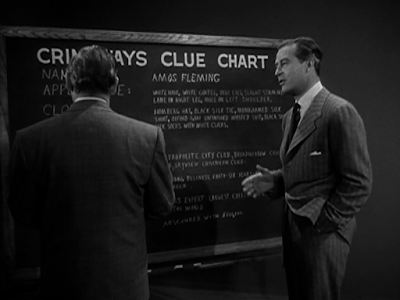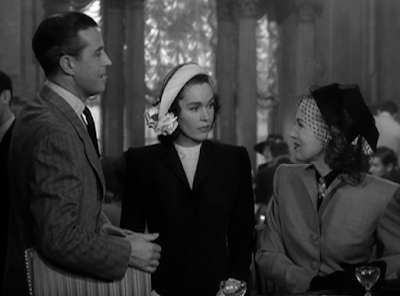April 9,
1948, release date
Screenplay
by Jonathan Latimer
Based on
the novel The Big Clock by Kenneth
Fearing
Music by
Victor Young
Edited by
LeRoy Stone, Eda Warren
Cinematography
by Daniel L. Fapp, John Seitz
Ray Milland as George Stroud
Charles Laughton as Earl Janoth
Maureen O’Sullivan as Georgette
Stroud
George Macready as Steve Hagen
Rita Johnson as Pauline York
Elsa Lanchester as Louise Patterson
Harry Morgan as Bill Womack
Harold Vermilyea as Don Klausmeyer
Dan Tobin as Ray Cordette
Richard Webb as Nat Sperling
Elaine Riley as Lily Gold
Luis Van Rooten as Edwin Orlin, a
reporter
Bobby Watson as Morton Spaulding
Lloyd Corrigan as Colonel Jefferson
Randolph aka McKinley (radio actor in the bar)
Frank Orth as Burt
Margaret Field as the second
secretary
Noel Neill as an elevator operator
Al Ferguson as the guard
Distributed
by Paramount Pictures
Produced
by Paramount Pictures
The first time I saw The Big Clock several years ago, I
wondered if it were really a film noir, probably because of the film’s many
humorous touches. Ray Milland’s onscreen presence frequently exudes warmth and
joviality, and the wonderful character of Louise Patterson, played by Else
Lanchester, provides many humorous touches. Her abstract sketch of the murderer
is just one example.
But then I heard that
No Way Out, released in 1987 and starring Kevin Costner, is a remake of The
Big Clock, and I thought: I need to see both films again. (Another remake
is a 1976 French film called Python 357, which I haven’t seen.) No
Way Out seems to be in heavy rotation lately on non-major-broadcast
stations, but I have never seen it from beginning to end. Still, it seemed much
more suspenseful than what I remembered from my first viewing of The Big
Clock. How could the two films be based on the same book? I decided to find
out, and I started with The Big Clock. (I have to admit that I have not
yet read Kenneth Fearing’s book of the same name: another book on my reading
list!)
The
opening credits in The Big Clock appear over two still shots, one of
magazine covers that bleeds into a longer one of a sundial. The sundial, it
turns out, is the murder weapon in the story that follows. After the credits finish rolling, the camera pans part of
the New York City skyline. Then it seems to track right into the offices of
Janoth Publications. I wondered if this was a new camera technique, one probably
made easier with new technology after World War II (the film was released in
1948).
The camera now
appears to be on the second floor of the building, but it is empty. Then George
Stroud, played by Ray Milland, steps off the elevator and checks out his
surroundings. Milland’s
voice-over explains what he is thinking in this opening sequence. When he realizes that a security guard is heading his
way, he hides behind a pillar. The security guard doesn’t see Stroud, so Stroud
continues on his way to what he calls “the big clock.” Earl Janoth, head of
Janoth Publications, likes clocks because he values, above all else,
punctuality and productivity. The big clock is Janoth’s idea: It is a
sightseeing feature for tourists who come to visit Janoth Publication, so it
makes money and keeps employees punctual. Inside the workings of the big clock,
George Stroud says/thinks
that, thirty-six hours ago, he was a “decent, respectable, law-abiding
citizen.” And the film then cuts to a flashback.
Thirty-six
hours earlier: George is busy at the office. He is the senior editor for Crimeways
magazine, one of many magazines published by Janoth Publications, and he has
just finished producing a successful article that will beat all his competitors
to publication. One of the secrets to George’s success is his Crimeways Clue
Chart, which he uses to track relevant and irrelevant details about everything
and everyone that could be the subject of a magazine feature. He thinks no clue
is unimportant, and it’s a strategy that works for him because he often gets
stories to press ahead of everyone else.
George’s
vacation is due to start the following day, and he and his wife Georgette are
overdue for a honeymoon (they already have a young son). His wife and son don’t
believe that the whole family will actually go on the vacation that they have
planned because George’s work has interfered with his family life in the past.
The film
cuts to Steve Hagen, Earl Janoth’s assistant, addressing a business meeting
about the need to increase magazine circulation. The Janoth company has
recently experienced a 6 percent recession. Janoth enters the meeting room,
acting like the ruling despot of his publishing company, so the conflict in
George Stroud’s life is made pretty clear from the start. It isn’t long before
Janoth uses George’s latest success against him: Research another story that
Janoth wants published or George is out of a job.
Pauline
York is Earl Janoth’s mistress. Her visit to his office doesn’t go as well as
she had planned. She wants more money for singing lessons than Janoth is
willing to give. She approaches George Stroud in a bar while George is waiting
for his wife and pitches the idea of writing an exposé about Janoth. George
isn’t enthusiastic about the idea, but because he just had a disagreement with
his wife about their vacation plans, he allows himself to be distracted by
Pauline long enough to get drunk and visit several night spots around town. One
of their stops is a secondhand shop, where he buys a Louise Patterson original
painting, with the artist herself trying to outbid him.
(This
blog post about The Big Clock contains some spoilers.)
George
and Pauline spend an innocent night on the town, and the only reason that
George ends up in Pauline’s apartment is because of the amount of alcohol he
consumes. While George is still trying to recuperate from the previous
evening’s events in Pauline’s apartment, Janoth shows up for a visit. George is
forced to leave by another entrance, and Janoth sees him from a distance
without recognizing him. Janoth enters the apartment, and he and Pauline argue.
Janoth kills Pauline in a fit of rage with the sundial that she and George had
picked up the previous evening in a bar called Burt’s Place.
Janoth
goes to Steve Hagen and admits to accidentally killing York. Hagen convinces
Janoth not to go to the police. Hagen instead goes to Pauline’s apartment and cleans
up the murder scene: He finds Janoth’s hat, resets a broken clock, goes through
Pauline York’s purse and takes out the handkerchief that George Stroud had
given her to dry herself after spilling a drink on her, and finds the sundial
(the murder weapon). He turns the sundial upside down and reads the bottom:
“Stolen from Burt’s Place, 988 Third Ave.”
After Janoth
tells him that he saw someone outside Pauline’s apartment, Hagen devises a plan
to find out the identity of the person and place the blame for Pauline’s murder
on him or her. He enlists the aid of George Stroud. Hagen doesn’t want Stroud
to know why he is conducting his investigation, but Stroud knows, of course,
because he was with Pauline on the night that she was murdered. Once again,
Stroud’s success causes him misery, this time with even more dire consequences.
He is now forced to use his investigative talents and his Crimeways Clue Chart—to
hunt for himself! The remainder of the film follows the investigation and George
Stroud’s efforts to stay one step ahead long enough to clear his name.





No comments:
Post a Comment